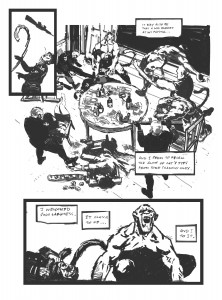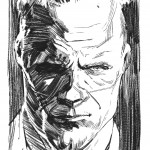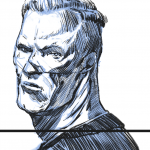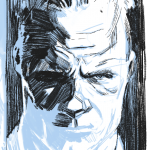“At every stage I am trying to think of the end-reader experience” Madefire’s Ben Wolstenholme talks motion books, Mono and more!
Is it easier to come up with the ideas when you are both writer and artist? Do you ever impose limits on yourself to give the title a certain look and feel or is it anything goes?!
BW: Timing is huge in leading the reader through the story and being able to surprise and delight – It’s great to not have to start from top left and lead the eye across a page – at the same time I personally believe that there is a ton of rigor from having to do this in print – that needs to remain on screen. I’d liken it to a design process; designing for print (stationery, packaging) versus designing for screen (title sequences, adverts, online, apps) – Great design has strong systems – in grids, in use of typography, in use of imagery and placement – most of the practices have been honed in print since it is such an absolute outcome – you print it and it works or it doesn’t. On-screen there is more room for theatre – but there is often a lot less discipline and rigor around layout and typography and overall hierarchy – to summarize this point i have found it very useful to create Mono in pages so that it can be printed later down the line – and I think this rigor has brought more discipline and restraint to how it reads on screen.

At the inking stage there’s more focus on how the art will break into layers to provide movement or depth. To me the inks are about creating tension and pace in the blacks – thinking through negative space and dialogue boxes. These can imply movement in themselves. Once the inks are done i send them onto FIn Cramb in Scotland for colouring; Fin has been adding a tone of mood and atmosphere in the color and texture – he’s doing a stunning job.
At every stage I am trying to think of the end-reader experience – what will that ‘feel’ like.
Do you draw everything out by hand or is it all digital?
BW: I started the first few pages of Mono using traditional pencil and a dip pen with indian ink – it was pretty messy – but had a nice ‘real-hand’ to it. I later moved to a digital process after Mono Episode 1. My digital process is all done in Painter 12 on a Wacom 21UX tablet – these are amazing tools. I tend to pencil quite quickly – blocking the scene out in black and white – positive and negative – penciling on screen allows you to mold the pencils in a way that’s more forgiving than using a real pencil and eraser – and faster. Then I ‘ink’ over the top of the pencils to get the ink working as I want it – for this I use a digital brush that I have customised to replicate the strokes of a dip pen – it took me a long time to get a decent match – I really wanted the resulting pages to feel like real dip pen strokes. For colouring, Fin Cramb uses a mixture of physical painting and Photoshop. Having said all that i’ve just gone back to pen and ink for a while – i was missing the mess!
I love your use of typography with the big special effects, is that your graphic design sensibilities coming to the fore?
BW: Thanks, yes I guess so – I wanted to have some fun with Type – there’s so much more to explore – and as a designer i am not happy with the way i’ve been treating it yet – but for now i have tried to keep structure and a really bold aspect to the type when it is a visual sound effect (SFX) – for example the PHTOOMs or the THUDs…you can’t beat a good THUD! The SFX aspect is really interesting – when building Madefire and Motion Books we set our goal of staying within a READING experience (not a watching experience). This means we wanted the user or reader to control pace and be able to follow the story by reading – so visual SFX are still vital and a lot of fun to work with. We do have some sound on the stories which can really help at more emotion and punctuation but they can’t be vital if people are reading without sound or headphones on. We’re learning all the time on this front.
Speaking of sound do you think it adds or detracts from the readers experience?
BW: Well – i don’t know how close we get to having sound right – I think we have a lot to learn – but we have set ourselves some rules for sound. Everything needs to be a reading experience – so the sound is generally there to create atmosphere and mood that adds to the read rather than replaces it. We will not employ voice over as it means the reader is no longer in control. The broad point regarding reading – and therefore sound – is that by giving the reader an active role – he or she is still creating whole chunks of the movement, character and scene themselves. This is part of the magic of books – they are not fully told – they are left to the imagination and that’s a wonderful thing. Each hint of movement – or dialogue box – or sound is only part of the full scene that the reader conjures in their mind. To me this is the key to making Motion Books – they are Books – not animation. Once you start puppeteering everything and doing voiceover then the reader become passive and the imagination is disengaged -what a shame. Then you need to be into full animation and deliver a fully realised experience like Pixar and that’s a different type of storytelling – and a lot more expensive to make!!
There’s so much room to move ‘Books’ forward – and to keep engaging the readers imagination in co-creating the story.
To be continued….
Ben had so much more to say on the subject of digital comics we spilt our interview in two, so check back in a couple of days for the rest of our epic chat to find out more about Mono, motion books, Moving Brands and what’s next for Madefire!







Preview: Exclusive look at Madefire’s Mono #4 by Ben Wolstenholme | Pipedream Comics
July 10, 2013 @ 6:15 am
[…] And to find out more about Mono creator and artist Ben Wolstenholme read our exclusive interview […]
"Digital lends itself to short form, episodic, tactile, visual reading - in short comics!" Part 2 of our exclusive interview with Madefire's Ben Wolstenholme | Pipedream ComicsPipedream Comics
July 25, 2013 @ 10:08 pm
[…] Earlier this week we grilled Madefire‘s Ben Wolsteholme about the secrets behind the creation of his man-monster MONO and his series The Old Curiosity Shop, but what about the man himself? Where does he see Madefire heading in the next 12 months, how does it impact upon his agency Moving Brands and how the hell did he get involved this crazy world of Motion Books anyway? (And why so many brands beginning with the letter M?!) The story continues… […]
News: Madefire's Liam Sharp and Bill Sienkewicz on new Sherlock HolmesPipedream Comics
July 30, 2013 @ 8:15 am
[…] you’ve read our exclusive interview with Ben Wolstenhome then you’ll know that Madefire has not only redefined digital comics with their unique brand […]
Fin Cramb and Sean Watson talk Madefire's Walk Don't Run motion book
April 20, 2014 @ 11:53 pm
[…] alongside big names like Injustice: Gods Among Us or Hellboy in Hell and Madefire originals like Mono or Captain Stone Is Missing, is an easy to miss title called ‘Walk Don’t Run’. […]
December 20, 2025 @ 11:58 am
Ein besonderer Sektor für Live-Streaming
bietet Spiele der besten Anbieter wie Pragmatic Play Live, Evolution und weiteren.
Zusätzlich bietet der Betreiber eine spezielle App für Android und iOS an. Die Plattform bietet insgesamt
über 10000+ Slot-Spiele und Glücksspielangebote von zertifizierten Entwicklern. Zur Anziehung neuer Spieler hat der Betreiber ein umfassendes Bonusangebot entwickelt, das sich aus Willkommensboni und
Cashback zusammensetzt.
Hier zeigt sich das Lucky7even Casino leider etwas “geizig” und ist nicht
auf High Roller eingestellt, da lediglich ein Neukundenbonus von bis zu 2.000€ angeboten wird.
Zusätzlich findest du in einem kleinen, aber hilfreichen FAQ-Bereich viele Antworten zu Themen wie Bonus, Spiele, Freispiele oder zur Bedienung
der Slots. In der Kategorie der Bücher-Spielautomaten kann das Lucky7even Casino auf ganzer Linie überzeugen und bietet Dutzende
von Spielen an.
References:
https://online-spielhallen.de/admiral-casino-sicher-spielen-grose-gewinne/
December 21, 2025 @ 9:43 am
Wenn du über den Kopf des Spielers gehst, kannst du sehen welcher Einsatz gesetzt wurde und kannst mit
einem Klick gegen den Spieler spielen. Im Casino kannst du Crash oder Schere, Stein, Papier oder Roulette spielen.
Redstone-Spielautomaten sind somit ein lebendiges
Beispiel für das Potenzial von Minecraft als Plattform für Kreativität und technisches Lernen.
Als erstes wird in der Zoll-Maschine ein Signal aus gelöst, das gerade so lang ist um den eingeworfenen Smaragd in die Sammeltruhe zu
transportieren. In der Glücksspielmaschine
wurden drei Zufallsgeneratoren verwendet. Die Ausschüttung ist dabei so gestaffelt, dass man mit 3 Äpfeln 4 Eisenbarren gewinnt, mit 3 Melonen 5 Smaragde,
mit 3 goldenen Karotten 6 Goldbarren und mit 3 Orchideen 7 Diamanten. Eine neue Runde wird gespielt, wenn man 1 Smaragd in den Trichter vor der Maschine geworfen hat.
Bei dieser wartungsarmen Slotmaschine müssen immer drei gleiche Gegenstände angezeigt werden, damit man etwas passendes dazu gewinnt.
Bei Slotmaschinen kann man, um die Gewinnchance zu minimieren, den jeweiligen Gegenstand prozentual weniger hineinlegen, damit dieser seltener
einen Dreier erreichen kann und man so einen Gewinn erhält.
Von einfachen Münzwurf-Maschinen bis hin zu komplexen Casino-Simulatoren zeigen diese Kreationen die nahezu unbegrenzten Möglichkeiten, die Minecraft und Redstone bieten. Abschließend lässt sich sagen, dass Redstone-Spielautomaten in Minecraft weit mehr sind als bloße Unterhaltung.
Viele Minecraft-Bildungsprogramme nutzen Spielautomaten-Projekte, um Schülern die Grundlagen der Elektronik
und Programmierung näherzubringen. Die Erstellung von Redstone-Spielautomaten ist nicht nur eine technische Herausforderung,
sondern auch eine Möglichkeit für Spieler, ihre Kreativität auszuleben. Auf Servern können Redstone-Spielautomaten als
Möglichkeit dienen, die In-Game-Währung zu verdienen oder zu setzen. Ein interessanter
Nebeneffekt der Redstone-Spielautomaten ist ihre Verwendung in Minecraft-Servern und -Welten.
References:
https://online-spielhallen.de/greatwin-casino-erfahrungen-mein-umfassender-uberblick-als-spieler/
December 26, 2025 @ 1:35 pm
You can access the entire game library, make deposits, claim bonuses, and contact support from the palm of your
hand. Welcome bonuses come with wagering requirements, which dictate how many
times you must play through the bonus funds before withdrawal.
One of the most compelling reasons players flock to a new online destination is the generosity
of its promotional offers, and this platform excels in this
arena. In the competitive world of online gaming, Australian players seek platforms that are
entertaining, secure, and fully legal. Licensed and protected casino,
with high-class support and regular promotions, promises to provide players with a reliable and exciting experience.
SkyCrown Casino is a great choice for Australian players looking
for a quality online gambling platform.
You won’t just get one welcome bonus at SkyCrown casino, as there are five bonuses in the welcome package.
There’s a mix of free spins, match deposit bonuses,
and weekly challenges to partake in. New SkyCrown players can claim up to $8,000 plus 400 free spins spread over five deposits.
Promotions and bonuses from SkyCrown Casino are designed to keep players interested and
encourage their activity on the platform. SkyCrown Casino pays great attention to its players,
offering a variety of bonuses and promotions that make the game even more
profitable and exciting. SkyCrown Casino is a quality
and innovative gaming platform that offers a wide range of entertainment for Australian players.
The platform provides players with the opportunity to enjoy real money gambling in a convenient and
secure online format. SkyCrown Casino is an exceptional platform for players looking to explore a wide array of games.
The platform supports traditional banking methods alongside cutting-edge digital solutions,
with most deposits reflecting instantly in player accounts.
References:
https://blackcoin.co/betway-login-my-account-in-south-africa-2025-step-by-step-opening-guide/
December 26, 2025 @ 3:58 pm
Our partnership with top-tier providers like 5 Wishes, Cash
Bandits, and Asgard ensures high-quality gaming with stunning visuals and engaging gameplay.
Whether you’re a fan of Pokies and Slots, Table games,
or video poker, you’ll find plenty to enjoy here.
Ozwin Casino is a well-known online casino that started back in 2020.
It has an excellent bonus program for both new and regular customers.
Use them to buy all the bonuses you want from our virtual store – deposit
bonuses, free chips, free spins, you name it. Note that match deposit bonuses, cashback bonuses, and
comp points bonuses at Ozwin Casino do not have a maximum cash-out
limit. It is advisable not to redeem consecutive free bonuses or free spins
without making a real money deposit in between. You can either select one of
those bonuses or enter a code you found through some other channel.
Ozwin casino has acknowledged that players absolutely love the possibility to
spin a cheeky pokie on the go.
Ideally, Ozwin Casino Support should be online 24/7, ensuring that players
can access help whenever they need it, regardless of the time zone.
Assessing customer support efficiency is crucial when choosing an online casino.
The Ozwin Casino mobile experience retains the core functionalities of the desktop version, including game variety, account management, and customer support.
References:
https://blackcoin.co/ecarte-poker/
December 27, 2025 @ 5:33 am
If you or someone you know struggles with problem gambling, use the self-exclusion tool
and contact national support services. This includes deposit limits,
time limits, self-exclusion and reality checks.
WinSpirit emphasises mobile-first access via a progressive web app
(PWA) and an optional Android APK. If you plan to
be a long-term player, evaluate the velocity of points accumulation against your
typical spend to estimate how quickly you will reach premium tiers.
You must withdraw using the same method you deposited with, which creates
complications if your original card expires or you close a
bank account. Some players report pressure to keep playing
while waiting for subsequent weekly releases. The $14,000 weekly withdrawal limit becomes
frustrating for bigger winners. Conversely,
Mark from Perth waited 8 days for a $850 withdrawal to his CommBank account after
submitting it on a Friday before a long weekend.
References:
https://blackcoin.co/ggbet-casino/
December 27, 2025 @ 9:37 am
“Realz brings together pokies, live dealers, jackpots, and bonus-buy slots in one clean, modern lobby. During our testing, we checked for mobile-first gameplay, fair terms, and banking options that suit Australians, including PayID, POLi, and Neosurf. This cross-platform integration provides real-world benefits like free hotel stays, dining credits, and exclusive event invitations. Players must complete all wagering requirements within seven days of receiving their bonus funds. Players must use their bonus funds within seven days of receiving them or the funds will expire. Bonus funds returned through the loss-back promotion carry a very player-friendly 1x playthrough requirement, which is significantly lower than industry standards.
But before you sign up, it’s a good idea to do some research to ensure you find the right casino. Choose how you want to deposit money into your casino account and make your first deposit. Some casinos will ask you to verify your identity by sending them documents such as your driver’s license or passport. The casino should have a good reputation for fair play and safe transactions. The benefit is that these platforms usually run faster than using a web browser because they don’t need to reload every time you switch games.
As you can see, the list of things you must check for every online casino with real money in Australia is staggering. It’s evident how players increasingly prefer to enjoy casino games from their portable devices. When we filter the best online real money casinos, we thoroughly test their customer support.
References:
https://blackcoin.co/27_best-high-roller-bonus-casinos-2022_rewrite_1/
December 29, 2025 @ 5:07 am
paypal casinos online that accept
References:
https://www.fightdynasty.com/companies/2025s-best-paypal-casinos-expert-verified-sites
December 29, 2025 @ 5:07 am
online casino real money paypal
References:
https://ghibta.org
December 29, 2025 @ 5:31 am
online casinos that accept paypal
References:
gramshort.com
December 29, 2025 @ 5:31 am
paypal casino usa
References:
popijob.com